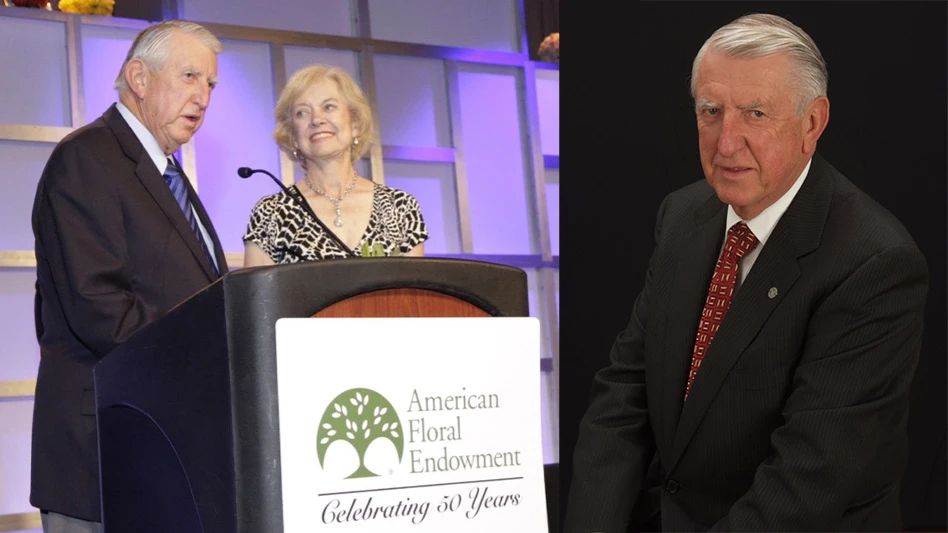
There’s an old cliché that a picture is worth a thousand words. However, when applied to Izel Native Plants, a picture has proven to be worth thousands of plantings for the average backyard gardener.
Izel is the dream of co-founders Claudio Vazquez and Amanda McClean. Commercial photographers by trade and hobby gardeners in their spare time, Vazquez and McClean were dismayed by their inability to source native plant varieties and gain practical insights outside of very limited educational resources.
Before Izel entered the horticulture market, much of the limited information and imagery about native plants was better suited to supporting a prairie restoration project than inspiring residential backyard gardeners. At the time, very few online databases focused on native plants.
The USDA database was limited to basic data like wetland status and synonyms. While wildflowers.org offered a bit more plant characteristic details, it lacked the intuitive, problem-solving functionality necessary for successful native gardening.
In addition, there was no way to input criteria like “groundcover,” “full shade,” “specific bloom color” or “local availability” and generate targeted recommendations. According to McClean, this meant struggling to identify not only suitable species for a region and its conditions but also to pinpoint retail nurseries or suppliers carrying those plant varieties.
“We used to be big readers of Garden Design magazine,” McClean says. “You’d be inspired and want (a particular plant variety), but getting it was always hard. So, we took that frustration and thought if we feel this, obviously other people feel this, and how hard could it be to build this website?”
The concept of a fully searchable and transparent database on native plants had been bandied about in horticulture circles for some time, but no one had yet acted upon it.
“In fact, the first (industry) talk we ever participated in — even before we’d made the connection with growers — was at the Chesapeake Conservation Landscaping Council. It was focused on whether plant databases were going to move online. Today, it’s hard to remember that there was a time when there was so little information.”
Undeterred by the daunting task ahead, in 2009, Vazquez and McClean embarked on a meticulous journey to build izelplants.com as a sophisticated yet user-friendly resource. This ambitious web-based project, launched in 2014 and spearheaded by McClean, demanded extensive collaboration with e-commerce and web development experts and a monumental effort to rectify the deficiencies of the USDA’s plant database.
Vazquez directed the creation of Izel’s comprehensive repository, providing detailed plant profiles, cultivation guidelines, precise native range maps and high-quality visuals of native plants in landscape settings. In addition, Izel invests heavily in educational content and outreach, which supports its broad customer service initiatives. They produce blog posts and email campaigns and participate in industry-based speaking engagements to address common questions and pain points experienced by customers.
Today’s robust database, which continues to be refined and expanded, is a powerful testament to Vazquez’s and McClean’s unwavering dedication and rigorous commitment to accuracy.
“They have a lot of people in the industry who look to (Izel) for information on native plants,” says Mandy Komes-Leifheit, territory manager for native plants at Midwest Groundcovers, based in St. Charles, Illinois, and one of Izel’s grower partners. “This has proven to be very valuable because there is such a miscommunication in the industry about native plants.
“Izel has grown this large following of people inside and outside the industry who look to them as a source of knowledge,” Komes-Leifheit adds. “And they do a really good job of that, in addition to working closely with their consumers and growers.”
Besides serving as an educational repository, Izel’s e-commerce strategy focuses on selling directly to the consumer — think Amazon, but for native plants. Through Izel’s consolidated online marketplace, consumers can choose native plant varieties from multiple nurseries, including regional wholesale growers. In addition, consumers can purchase in limited quantities that most plant growers would pass on.
Izel’s timely entry into the horticulture market pre-COVID and its ability to pivot during the pandemic’s stay-at-home mandates allowed the fledgling company to ride the wave of the hobby gardening movement.
However, garden centers weren’t selling a lot of varieties of native plants at the time, Komes-Leifheit says. In fact, native plant varieties were considered a hard sell.
“You’d go into garden centers, and you’d see these gorgeous blooming phlox, and they just sold themselves,” she says. “But natives don’t behave the same in containers. So, garden centers didn’t have them, and there was this huge need for somebody to get this material to homeowners and small landscapers because they couldn’t get it otherwise.”
Similar to their educational approach, Vazquez and McClean believed a successful e-commerce approach had to address consumer needs. Izel needed to become the critical conduit to get native plant materials shipped directly to homes and in the hands of gardeners.
“In light of the notoriety natives have gotten in the last five years, I think Izel was in the right place at the right time,” Komes-Leifheit says. “All of the sudden, this boom for native plants started, and their name was already out there, so they were able to grow on that momentum.”
McClean explains that Izel’s platform prioritizes transparency by providing customers with a comprehensive native plant selection portal linking them with its grower partners. This includes providing consumers with advanced filter capabilities that allow customers to find native plants based on regions, growing conditions, color and bloom time.
Equally important is the site’s ability to provide consumers with abundant information about the growers they’re purchasing from, which, according to McClean, empowers them to make informed decisions based on a preferred provider or region of origin. Consumers can also specify when they wish to receive their plants, significantly improving the experience for those managing busy schedules.
“They want to know where the plants are grown, for either the provenance or regionality,” Vazquez says.
Furthermore, Izel encourages its grower partners to utilize their branded packaging, reinforcing their identity and pride in their products and strengthening relationships with customers, McClean says. This stands in contrast to blind shipping practices, where the grower’s identity is obscured, potentially diminishing their sense of ownership and accountability if any quality issues arise.
Today, Izel processes around 4,000 native plant orders annually.
North Creek Nurseries became Izel’s first major plant partner in 2017. Its relationship with the Landenberg, Pennsylvania-based wholesale propagation nursery proved to be a relationship that would pay dividends for the fledgling company.
Both Vazquez and McClean credit North Creek President Steve Castorani for taking a chance on them, as well as taking them under his wing and mentoring them in developing their business model.
At the time, many industry insiders were skeptical that Izel’s business model could work. Castorani saw potential, although he admits to harboring doubts at first. It wasn’t until McClean presented to him how the website’s functionality would serve clients that “the spark” went off for him.
“Seeing it was believing it, and there was something about it that really grabbed you,” Castorani says. “There are a lot of different plant sellers out there, but there was something about (Izel’s business model) that was very different from how you imagined you could sell (native plants).”
Izel’s is successful because Vazquez and McClean envisioned a solution to an entrepreneurial challenge, and then they made it work.

Izel’s e-commerce strategy focuses on selling directly to the consumer.
“Claudio and Amanda developed a business model, and they were able to bring (native plant) growers together to support their (initiatives) while helping those growers grow their own businesses,” Castorani says. “And for us, they did a lot to grow a segment of our business that we often had to turn away. Now, we can refer those clients to Izel and suggest they try them out.”
In the horticulture industry, establishing an e-commerce strategy like Izel’s was no small feat, Castorani says.
“I’m really proud of them,” he says. “I’ve been in this industry a long time, and you don’t always see people doing groundbreaking things. Here’s a new business model that’s making headway in our industry.
“They’ve done the right things,” Castorani adds. “And they’re not a threat to the wholesale market. Instead, they’re satisfying a niche to get more native plants to consumers. And that’s pretty exciting.”
Today, Izel works with eight partners and, according to Vazquez, they are negotiating to add a few more in 2025. Horticulture is a small industry, and Vazquez explains they are selective about whom they partner with because growers specializing in native plants are such a small part of the overall horticulture community.
“We’re seeking partners who can complement our offerings in the type of plant or species selection,” he says. “But this can be a challenge.”
He explains that potential grower partners must be able to filter out Izel’s unique customer focus. Otherwise, there’s unwarranted and unwanted competition.
“This really starts to narrow down the growers who are compatible with us,” Vazquez says.
In addition, they’re seeking new grower partners who can complement Izel’s growth strategy and its push westward.
The native plant industry is experiencing a robust growth spurt, which Vazquez and McClean say is evidenced by its expanding presence within horticulture’s broader North American landscape. This shift is seen as the horticulture industry’s major trade shows increasingly schedule native plant speakers and educational events to engage with and meet the interests of a wider audience.
In addition, Izel’s recognition as the Perennial Plant Association’s 2022 Retailer of the Year — a first for a native plant retailer — acknowledged the growing significance of the specialized sector.
“We really celebrated that as a success for us and for the greater industry,” McClean says. “PPA is not native-focused, so for them to award somebody from a more niche (market) says a lot.”
The culmination of the increasing demand for expertise, both in direct-to-consumer education and within the industry itself, is signaling a sustained trajectory of expansion for native plants. Today’s native plant movement, according to Vazquez, has transcended the realm of fleeting trends, establishing itself as an enduring force within horticulture.
“Ten years ago, certainly beyond that, there were questions within the greater industry about whether this was ‘a movement’ or ‘a fad,’” he says. “At this point, there’s no doubt that this is not a fad.”
While the movement’s ascendancy is clear, it has met resistance from those within the industry. Social media has become a battleground for opposing perspectives, with proponents of traditional horticulture sometimes viewing the rise of native plants as a threat to their established practices.
Mainstream acceptance hasn’t been easy for native plants. Early, simplistic messaging positioned natives as universally “better,” which created friction when they didn’t seamlessly fit into traditional ornamental aesthetics, says Shannon Currey, Izel’s director of education and outreach.
As a result, this led to pushback and misconceptions, including the notion that all non-native plants are inherently detrimental. Currey says a more mature perspective sees the value of well-adapted introduced plants and emphasizes a holistic approach to landscaping, focusing on the triad of “right plant, right place, right purpose.”
“We try to be very constructive,” Currey says. “How do we build landscapes that serve people, plants, wildlife and the big picture? Native plants are not the only way to do that, but they are a necessary way to do so. Getting people to understand your goals for that landscape and your goals for that plant are all part of making those choices.”
This evolution reflects the industry’s growth and the need for constructive dialogue rather than rigid, exclusionary viewpoints. Vazquez speculates that this pushback, while occasionally heated, likely stems from a desire by some to maintain relevance in an evolving market.
Nevertheless, he maintains that native plants’ momentum is undeniable, and their integration into mainstream horticulture continues to accelerate.
“(Natives) are in it for the long run,” Vazquez says. “You can no longer ignore native plants.”

North Creek Nurseries was Izel's first plant partner.
This article appeared in the April 2025 issue of Greenhouse Management magazine under the headline "Solving the native plant conundrum."
Mike Zawacki is a Cleveland-based writer and frequent contributor to GIE Media’s horticulture publications.

Explore the April 2025 Issue
Check out more from this issue and find your next story to read.
Latest from Greenhouse Management
- The HC Companies, Classic Home & Garden merge as Growscape
- Eason Horticultural Resources will now officially be known as EHR
- BioWorks receives EPA approval for new biological insecticide for thrips, aphids, whiteflies
- ScottsMiracle-Gro transfers cannabis subsidiary to focus on core lawn and garden business
- Ellen Mackenbach-Lakeman appointed new CEO of Dümmen Orange
- Southern Garden Tour sets 2025 dates for trial garden open houses
- Belgian thermal screen manufacturer Phormium launches Noctis Thermo
- New book explores plants that thrive in Rocky Mountains








